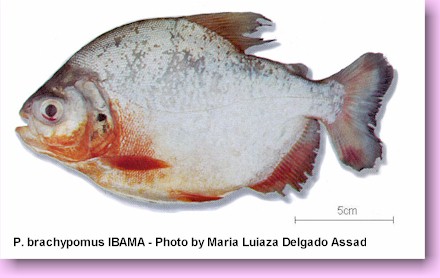genus Piaractus
Common Names: red bellied pacu (Pirapitinga, Morocoto, Cachama)
This is one of the most imported species for the aquarium trade and the one most often released in non-native waters. Machado-Allison (1982) revised the pacus and provided distinguishing characteristics for Piaractus brachypomus. The genus with 2 recognized species (P. brachypomus, P. mesopotamicus). Externally they are difficult to identify, especially when full grown adult. They have an economic importance to South America and are known as Tambaqui or Pacus. Piaractus is considered a subgenus of Colossoma in several previous classifications (eg., Norman 1929; Gosline 1951; Géry 1972, 1977) but not in others (e.g. Eigenmann 1915; Nelson 1961; Machado-Allison 1982). The basal position of this group among the Serrasalminae was also advocated by Gosline (1951), based on dental, fin, and osteological characters, and by Nelson (1961), based on swim bladder morphology and other internal anatomical features. Colossoma, Mylossoma and Piaractus are floodplain specialists, they do not occur outside the main stem floodplain. They are even absent from the Rio Negro. There seem to be at least 3 groups according to the molecular data and one of the sub-units is actually more related to Mylesinus than to the rest of Myleus.
Piaractus brachypomus possesses a unique rare feature, the adipose fin is rayed in adults. The species exceeds 600 mm SL, the juveniles are spotted (body) and the fins are dark edged in the young, they also have a distinctive large blotch on the opercle (see image at left). Young ones resemble the piranha from the Orinoco Pygocentrus cariba, but completely harmless. However, in the aquarium when placed with a group of piranhas, the species mimics the piranha feeding behavior, even joining in the feeding frenzy. I don't know if this is normal behavior in the wild, but in the aquarium, it is an entirely different matter. Adults are uniformly dark or marbled.
This fish grows large as does the next one (85 cm SL and about 25 Kg weight).
This species is very close in appearance to P. brachypomus. The largest external difference is the scales being much smaller in P. mesopotamicus than P. brachypomus.
Synonyms include; Piaractus metrei, Colossoma metrei, and Colossoma mesopotamicus. Native Range; Tropical America. Restricted to the La Plata Basin, South America (Machado-Allison 1982).
Species grows to about 85 cm SL weighing similar to the previous species. This fish is also frequently released by hobbyist when this giant grows to big for the home aquarium. Often misidentified as a piranha by fish and wildlife authorities when captured in U.S. waters.
USE YOUR BACKSPACE TO RETURN OR CLICK HERE TO VALID SPECIES PHYTOPHAGOUS PAGE
USE THIS LINK TO RETURN TO RESEARCH PAGE
TO RETURN HOME CLICK HERE
The OPEFE web site and its contents; is disclaimed for purposes of Zoological Nomenclature in accordance with the International Code of Zoological Nomenclature, Fourth Edition, Article 8.3 and 8.4. No new names or nomenclature changes are available from statements at this web site.
Copyright© 1994-2012 Oregon Piranha Exotic Fish Exhibit (The OPEFE fish exhibit is permanently CLOSED as of 2000) Sutherlin, Oregon. Information posted on this web site is archival data on fish scientific classifications and other information. DISCLAIMER: The copyrighted material may not be used for any purpose other than private study, scholarship or research. Cited information requires credit and this link www.opefe.com. All rights reserved. All images shown (unless otherwise noted) is property of OPEFE.
UPDATED: 12/27/2011
